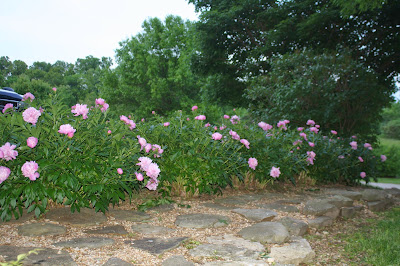On this snowy late-February
morning, I stirred up a cake. My inspiration, besides the cold weather and
being cooped up inside the house for the fourth day in a row because of a
winter bug and my husband’s pitiful plea for something baked and sweet, was a
recipe in the rural electric cooperative magazine that came in today’s mail. It’s
called an Irish Tea Cake, and that’s plenty to recommend it. But as I read
through the ingredients, all just plain and simple, I realized it must be almost
identical to my very first cake. Nostalgia overwhelmed me, and I set to baking …
and remembering.
It was a day much like this, and
I was probably nine years old. The snow was flying, and I was tired of
being cooped up inside with only my two younger brothers for company. So I did
what I often did at such a time: I walked down the street to my great-granny’s
house, ostensibly to keep her company but really to entertain myself. Granny
let me do stuff, and I also just loved to rummage
around through the old stuff in her big old house.
Not only was her house old and
her stuff old, Granny (Mary Magdalen Luna Bushong, 1882-1971) was old. She was 78, and in 1960 that seemed pretty old to a nine-year-old.
But still, it was fun to be at Granny's. Widowed for several years, she lived alone in a rambling, two-story turn-of-the-century farmhouse in the
middle of town. Actually, Granny had a whole farm in town, with a huge garden, an
orchard, a chicken house where she kept about 200 hens, a big barn across the
highway where she kept a milk cow, a smokehouse, a brooder house, another barn
and a building where she stored things.
The old house had had a bathroom
added a few years earlier, but there wasn’t much else about it that was modern.
Its source of heat was a Warm Morning stove in Granny’s sitting room; it kept
that room cozy but did little for the rest of the downstairs and nothing for
the upstairs. So on a cold winter’s day, it was like a refrigerator up there.
The best place was Granny’s
kitchen, where a big old wood-burning cookstove held pride of place. My
grandmother had insisted on getting Granny a modern electric range from the
Western Auto, but she refused to part with the old wood-burner and always used
it in the winter months.
That stove radiated comfort. I
loved to curl up on the rag rug behind it with a book and read. That was where baby
chicks that Granny ordered from the hatchery (delivered to the post office in a
cardboard box with breathing holes, cheeping for all their might!) made the
transition from life in a shell to life on Granny’s farm in town. They stayed
behind the stove, little downy balls of fluff, until Granny deemed them ready
to move to the brooder house.
Warmth was not the only wonderful
emanation from that wood stove; the aroma from whatever Granny was cooking on
or in it seemed more intense. At any given time, there would be a baked sweet
potato ready to melt a fat pat of butter, a cast-iron skillet with wedges of leftover
cornbread, some pieces of bacon saved from breakfast, or a bubbling pot of
pinto beans or chicken and dumplings going on top. Things just tasted better
when cooked on that old stove.
On the day in question, I wanted
to make a cake. Mom was not one to let me cook – too much mess, and Mom never
could tolerate a mess (still can’t.) But Granny said we’d make us a One Egg Cake.
From a high shelf in her cupboard to the right of the cast-iron sink, she pulled
down a rarely-used, old black-bound cookbook; I believe it was a Searchlight. She opened its yellowed
pages and searched until we found the One Egg Cake
recipe.
I asked Granny why it was called
that. She said it was from the days when women hardly had anything to cook with,
so they found ways to make a little go a long way. Of course, she was referring
to the Great Depression, a time Granny remembered well. It may seem ironic to
think that anyone with 200 hens would skimp on eggs, but eggs were the currency
of many women of Granny’s day. Even by the time she helped me make my first
cake, when the Great Depression was a memory, I doubt if Granny spent much, if
any, money at the grocery store; she still traded eggs for what she could not
grow or raise herself – things like sugar, coffee, or tea. Self-sufficiency and
thrift were so deeply ingrained that she never overcame her tendency to “use it
up, wear it out, make it do, or do without.”
We made ourselves a one-egg cake,
and we ate most of it for dinner (no lunch in those days) while it was still warm. Not too sweet, a little bit
dense, and full of the flavor of its simple ingredients: butter, sugar, vanilla
(Watkins, of course), egg, milk, flour, baking soda and salt. The butter, milk
and egg had all come from Granny’s farm in town. That little cake stood alone;
it needed no frosting or sauce to enhance its importance.
After dinner, Granny always took
a nap on her little divan by the Warm Morning, so I braved the arctic regions
upstairs to nose around. I started (where I always did) on the sleeping porch where my
great-grandfather’s doctor tools were stored in glass-topped cases. Laid out
neatly, as if he might need to use them again at any minute, the shiny silver
implements were fascinating and a bit intimidating. Then I went into a
bedroom where his old medical books from the early 1900s were still stored in a
bookcase. Things have changed a lot in medicine since then, but not everything.
The graphic illustrations of women in childbirth provided an early lesson in
the birds and the bees; equally fascinating was the tome with the descriptions, complete with
lurid photos, of hideous deformities and growths that can afflict human beings. It's funny, the things one remembers ....
I rummaged through dresser drawers and wardrobes and trunks, fingering quilts and linens and old clothing and old photos (oh, those photos!), and when I was thoroughly frozen, I
came back downstairs and helped myself to some more of my cake. I did a few
things to help Granny, such as polish her black shoes, paint her fingernails
and read a story to her from the Grit. And then I pulled on my red rubber galoshes,
my wool gloves and hat and warm coat, and walked the block to home.
It was an ordinary day from my
childhood, like so many others. And yet, I now realize that, truly, it was an
extraordinary day, one that I’d love to relive. As I look out at the big, fat
snowflakes drifting down and mounding around the door, I pour a second cup of
Constant Comment and help myself to another slice of what I’ll call my Two
Egg Cake. It may not be exactly the same as my first cake, but it’s close
enough.
If you’d like to try my Two Egg
Cake, here’s the recipe. Let me know if it conjures up any memories for you. You
may prefer to call it
Irish Tea Cake
½ cup butter, softened
1 cup sugar
2 eggs
2 teaspoons vanilla
1 ¾ cups all-purpose flour
2 teaspoons baking soda
½ teaspoon salt
½ cup milk
Preheat oven to 350 degrees. Grease and flour a 9-inch round cake pan.
Beat butter and sugar together until creamy; add eggs, one at a time, beating
well after each one. Stir in vanilla. Blend flour, soda and salt together in
separate bowl. Add to egg mixture alternately with milk. Pour into prepared pan
and bake about 30 minutes or until toothpick comes out clean. Cool in pan on
rack for 5 minutes, then remove and completely cool. May dust top with powdered
sugar, if desired, when cool.































